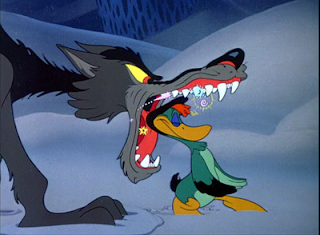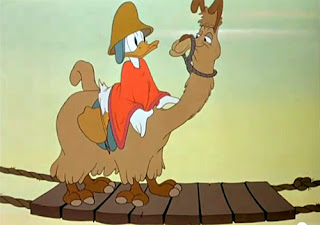Having dedicated so much time and resources to the war effort, not to mention able-bodied employees who enlisted, Walt Disney was far from producing another feature with a standalone story. As a means of keeping the feature division alive, the remainder of the 1940s was spent releasing package films that comprised several shorter subjects strung together. Some films like the upcoming Fun and Fancy Free or the company's last package film, The Adventures of Ichabod and Mr. Toad - released at the decade's close - consisted of fairly long narratives, the films showcase just two disparate segments.
The studio's first post-war release, 1946's Make Mine Music, is closer to a shorts festival. The film contains ten segments, none of which runs longer than fifteen minutes, with the majority clocking in at a Silly Symphony-sized six to seven minutes. It's like a Walt Disney mixtape. The film's unifying thread is, as the title implies, music. Though unlike Fantasia which puts the music front and center, placing all attention and artistry at the composition's mercy, Make Mine Music is a lot more frivolous. Much of the onscreen action derives from literal translation of the lyrics sung by some of the 1940s top stars, including Dinah Shore and Nelson Eddy. Many segments let the music recede almost entirely into the background having been usurped by narration.
The first sequence in the film, The Martins and Coys is - as it's opening title tells us - a rustic ballad sung by the vocal group the King's Men. The short tells the story of a generations-long feud between two backwoods families, a la the Hatfields and McCoys, who live side by side and spend every waking moment aiming their rifles and firing at their neighbors. Eventually all of the bullets hit their targets and both families ascend to heaven, save one member of each clan, a voluptuous girl and a goofy, yet strapping man. As the survivor's deceased relatives look down from their heavenly perch, they discover to their unending dismay that the two progeny have ceased hunting one another and fallen madly in love. The two are soon wed and the joke is that now the warring continues as they bicker and feud just as before, just under one house.
The segment is fairly rote with little to single out. The most interesting piece of animation is a wide shot showing the two shacks facing one another and anonymous puffs of smoke volleying back and forth, not a single rifle or shooter to be seen. The prevalence of guns and violence in this sequence caused Disney to excise the short completely from all home video releases, which is incredibly ridiculous because the segment is very broad and silly and I sincerely doubt the viewing of such material would result in our children subsequently taking up arms. Thankfully the section is available for viewing online.
The next piece in the film is the closest in style to Fantasia and that's because it was in fact originally designed for the earlier film. Initially intended as a showcase for Debussy's "Clair de Lune", Make Mine Music substitutes the more contemporary tune "Blue Bayou". Called a tone poem and set in a twilit swamp, the scene follows a stork as it soars through the night sky. The scene is very delicate and subtle, featuring some nice multiplane work and excellent water effects with the moon's reflection breaking apart as the swamp ripples. It feels incredibly out of place in this rather upbeat and energetic film, but that makes it all the more worthwhile.
Speaking of energy, the third sequence in the film, "All the Cats Join In" perfectly marries the big band busyness of the great Benny Goodman and his Orchestra with a jumping, jiving piece of animation that literally draws itself as it goes. The section opens on a shot of a sketch book where an alley cat is erased and replaced with a fresh-faced teenage boy. He is quickly drawn surrounded by a jukebox, phone booth and all of the other accoutrements of a first-rate malt shop. With the great Goodman and his band blaring out of the speaker the boy calls to invite his girlfriend who jumps up, into the shower and out the door. All the local teenagers end up at the shop where they drink sodas, eat ice cream and dance until the jukebox bursts.
The section is easily one of Make Mine Music's best. The vitality in every pencil stroke of animation, even the meta pencil stroke of the pencil animating the ensuing scene, is infectious. It is one of the greatest fusions of animation to music and rhythm in film history. But above all else it is just a whole lot of fun. Several animators worked on the sequence but the one who makes the most lasting impression is Fred Moore, whose infamous drawings of nude women were legendary on the Disney lot. These girls are the models for the teenagers in "All the Cats Join In" (they're also the basis for the design of Fantasia's centaurettes). Moore himself animates the surprisingly risqué section featuring the teenage girl at home. The scene shows her stripping down and hopping in the shower, her body dancing in silhouette behind the shower door. The gags in the sequence are all solid, from the preening younger sister who longs to join the fun to my favorite wherein the animated pencil quickly draws a stop light to halt the half-drawn car full of teenagers so it can finish drawing a back axle.
Despite some interesting water special effects, the film's fourth segment, animated to the ballad "Without You", leaves very little impression. The same goes for the failed attempt at marrying animation with live-action ballet in the "Two Silhouettes" sequence, which in theory sounds like a noble experiment but comes off clumsy and uninspired. Sandwiched between these two pieces is arguably Make Mine Music's most famous sequence, the retelling of "Casey at the Bat". The section opens with stills of a beautiful turn-of-the-century tableaux, showing all of the local ladies and gentlemen turning out in their greatest finery to watch a baseball game. From there the section comes alive with some solid character animation. There is a short, ill-tempered manager; a Jimmy Durante-inspired pitcher; a gruff Irish umpire; a batter with a meddlesome mustache; and of course, Casey, whose hubris is exuded in every movement he makes. Besides these caricatures and a few whimsical touches, not much of "Casey at the Bat" really sticks. It seems that the segment is most fondly remembered for the poem that inspired it. Disney's adaptation doesn't bring much more to the table.
That being said, there are some
wonderful elements in the sequence. The subtle nods to Russian dress embedded in
the animal designs is splendid, particularly Sasha the bird's ushanka cap and
the pegged pant-like legs of Ivan the cat. Having the title and later the signs
in the village written in Russian shows a quality of care and attention to
detail that differentiates the segment from some of the more slapdash efforts in
the package films. There are some choice bits of animation as well, with the
shadow of grandpa's beard morphing into the wolf, who when we him meet later is
a truly menacing character, all fangs and drool and piercing red eyes. He is a
much more horrific wolf than the antagonist in The Three Little Pigs
from a decade earlier.
"Peter and the Wolf" is followed by a welcome return from Benny Goodman who pares down his orchestra to present the tune "After You've Gone" which scores a quick little scene showing anthropomorphized instruments goofing around. I can't help but think that the two minute segment would have been better utilized at the beginning Make Mine Music as a snappy little credit sequence setting the mood for the film. As it stands, sandwiched in the second half of a film relying more and more on traditional narrative, the fun little number falls through the cracks.
I must confess that I am a bit of a sucker for the love song portion of the film, sung by the Andrews Sisters, who tell the story of "Johnny Fedora and Alice Bluebonnet". It is treacly and saccharine but there is something in the tale of two hats falling in love in a window display that taps into the latent hopeless romantic in me. It doesn't hurt that the song is gentle and catchy and the effective animation of the hats so charming. The way Johnny is made to have a smiling mouth when poised on a pedestal is truly creative work. There is not much to chew on but as a love story goes it manages to squeeze in all of the genre's trappings while presenting them in a new, imaginative environment.
The film ends with the tragic tale of Willie the
whale who is possessed with an operatic voice and longs to put it to good use. Sailors rave of the mellifluous voice they have heard emanating from the whale during their voyages on the high seas. The opera impresario Tetti-Tatti believes this is due to an opera singer being swallowed by the beast, not the whale's own true talent. Seeing the fortune he could make if he brought the singer back, Tetti-Tatti pursues Willie, whom he discovers serenading enraptured sea gulls and sea lions. We then cut to Willie performing several famous pieces in an elegant symphonic hall, from Pagliacci to Mephistopheles. The crowds grow more ecstatic with each successive performance. Willie's picture graces the cover of Life magazine. He is front page news.
On the whole, Make Mine Music is a slight but enjoyable work. While not all of it sticks, the filmmakers were careful never to overstay their welcome. No sequence in the film drags, even the most mundane or trivial. This alone is a strong advancement from the plodding tedium of most of The Three Caballeros. To judge the film on its own merits is noble, but it can often be difficult separating the package film from the studio's vaunted lineage. To think that Bambi was released just a few short years prior makes Make Mine Music even more trifling.








































